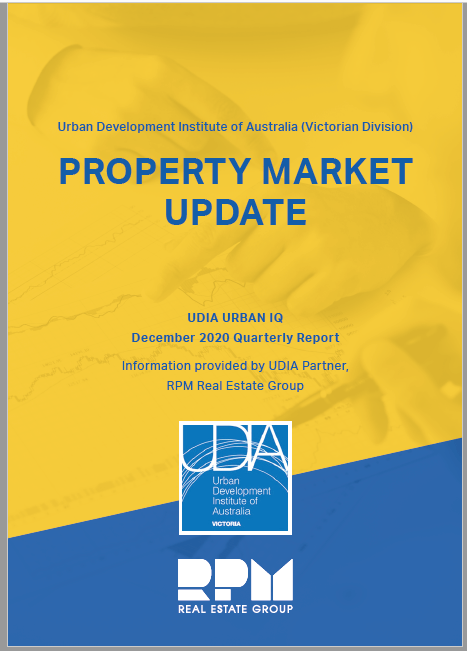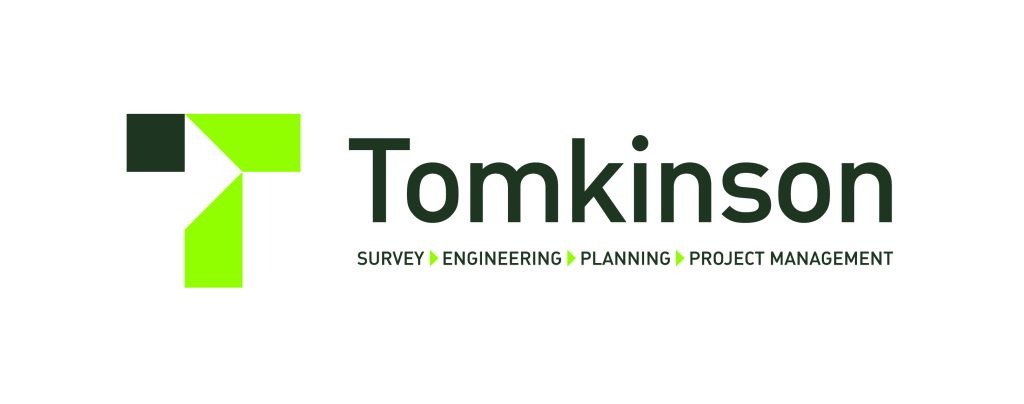
UDIA Victoria, in partnership with RPM Real Estate, has released the latest quarterly URBAN IQ research publication.
The research provides data, research and analysis to help our members understand the conditions in which we are operating.
Read the full URBAN IQ report, December 2020 quarter, in English
Read the full URBAN IQ report, December 2020 quarter, in Mandarin
Summary of Key Findings
December Quarter 2020
NATIONAL GROWTH / OUTPUT
- GDP growth is expected to strengthen in December quarter 2020, as the lifting of restrictions in Victoria contributes to a further improvement across a range of indicators of economic activity.
- The accumulation of savings and return to normal income for more people has left households with significant disposable income. This has started to manifest into the economy, highlighted by retail trade in Victoria rising by 12.2% in December quarter 2020, from the previous quarter.
- Greater household savings is also giving confidence to more people to take advantage of the $25,000 HomeBuilder Grant and enter the new house market or undertake a substantial renovation. From HomeBuilder Scheme’s inception on the 4th of June 2020 to the end of January 2021, there have been 65,413 applications for new builds and 16,504 applications for renovations.
- The new dwelling purchase by owner occupier index examines prices for new dwellings (excluding land) and major renovations. This index increased by 0.7% in December quarter 2020, from the previous quarter. However, without the HomeBuilder Scheme, which provides owner occupiers with a $25,000 rebate when constructing a new dwelling or undertaking a major renovation, this index would have risen by 1.3%.
EMPLOYMENT – VICTORIA
- Official employment data from the ABS shows Victoria gained 170,300 jobs over December quarter 2020, as industries increased output and could trade closer to capacity after the easing of lockdown restrictions. This was more than half of all jobs created nationally during the same three month period.
- Part time jobs, which experienced greater job losses in response to the lockdown restrictions, accounted for 57% of the Victorian increase to employment in December quarter 2020, and constituted 96% of the national increase.
- Strong jobs growth led to the number of persons working reduced hours or stood down completely decreasing substantially by 262,400 persons in Victoria.
- Wage indicators showed a similar story over December quarter 2020, as total wages paid improved by 8.2% in Victoria. This highlights the increase in employment and more people earning their full wage and moving off JobKeeper.
CONSUMER SENTIMENT
- The Westpac-Melbourne Institute Consumer Sentiment Index remained in optimistic territory, with a reading of 107.0 in January 2021. However, this represented a decline of 4.5% from the Index result in the previous month, with the reduction in sentiment attributed to short lockdowns and temporary state border closures after the emergence of COVID–19 local cases and clusters.
- Property market sentiment was more buoyant though, with the index for time to buy a dwelling and house price expectations both improving slightly.
- Business conditions returned to positive territory in October, coinciding with Victoria coming out of lockdown, with the index peaking at +13.9 points in December 2020, before falling back to +5.3 points in January 2021.
- Although remaining positive, both trading and employment conditions experienced a sizeable pull back in January, as business operations were significantly reduced after the implementation of short lockdowns and state border closures.
VICTORIAN POPULATION
- Victoria gained just 4,704 people during June quarter 2020 (latest available data), lifting its estimated resident population to 6,694,884 people. This was the lowest increase in population since June quarter 1997, attributed primarily to the collapse in overseas migration.
MELBOURNE RESIDENTIAL MARKET PRICES
Over December quarter 2020, sales recorded a preliminary median:
- House price of $941,000 (+9.5% change from the previous quarter, and +9.2% from the corresponding quarter a year earlier)
- Unit price of $639,000 (+2.5% from the previous quarter, +0.4% from the corresponding quarter a year earlier)
- New home sales activity escalated considerably through December quarter 2020, supported by HomeBuilder Scheme pulling forward future new house demand into 2020 before the expiry of the $25,000 Grant. However, that money is not being used by purchasers to increase their expenditure on land. Consequently, the land market recorded a preliminary median land price of $303,500 (-0.7% change from the previous quarter, and -1.1% from the corresponding quarter a year earlier). This means the median lot price is now below its mid 2019 cyclical low, and at its most affordable level since December quarter 2017.
LOANS BY DWELLING TYPE
- The number of new owner occupation loans in Victoria increased by 13.1% in December quarter 2020, from the previous quarter, reaching 32,259 approvals.
- Growth in new loans for residential land (61.2%) and the construction of a new dwelling (79.6%) surged further in December quarter 2020.
- The State Government initiative to temporarily reduce stamp duty payable has benefitted newly erected dwellings more, which are eligible for a 50% cut. This has led to new loans for newly erected dwelling loans rebounding to lift by 4.9% in December quarter 2020.
- New loans for established dwellings rose 8.0% over December quarter 2020, from the previous quarter.
VALUE OF LOANS BY PURCHASER TYPE
- The total value of new owner occupier loans (excluding refinancing) in December quarter 2020 increased by 16.5% compared to the previous quarter.
- The total value of new loans to investors (excluding refinancing) stabilised during December quarter 2020, contracting by a marginal 0.5% from the previous quarter. Notably, the value of investor loans for established dwellings and residential land increased. This reflects a shift in investor demand to detached houses, which mirrors the shift in tenant demand to lower density dwellings, and away from units.
NUMBER OF LOANS TO FIRST HOME BUYERS AND NON-FIRST HOME BUYERS
- Quarterly growth in the number of new first home buyer loans accelerated to 16.0% over December quarter 2020 to 12,676 loans. This is commensurate with the record number of first home buyer loans in 2009, as the total dollar amount of grants available to first home buyers during the second half of 2020 was also similar to that in 2009.
- In December quarter 2020, non-first home buyers recorded 20,662 loans (excluding refinancing), equating to an increase of 7.4% from the previous quarter. This volume is around the long term average.
- As a result, first home buyers’ share of total new owner occupier loans edged higher to 38.0% in December quarter 2020. This was its highest proportion since the post GFC period when first home buyer incentives were as similarly attractive.
AVERAGE LOAN SIZE – FIRST HOME BUYERS AND NON-FIRST HOME BUYERS
- Over December quarter 2020, the average loan size to first home buyers and non–first home buyers both increased by around 3.0% from the previous quarter. This was attributed mostly to the solid growth in the median house price.
- At December 2020, the average loan size attributed to a non-first home buyer was $58,470 above the average loan size to a first home buyer ($425,200). After converging to be almost identical at March 2019, the divergence in average loan size between non–first home buyers and first home buyers widened throughout the remainder of the year and has remained significant during 2020.
BUILDING ACTIVITY: VICTORIA
- Victoria recorded 15,039 dwelling approvals in December quarter 2020, equating to a 7.3% decrease on dwelling approvals in the same quarter in 2019. However, total approvals during the twelve months to December 2020 of 62,508 dwellings were still 8.3% above the corresponding figure twelve months to December 2019.
- New detached houses recorded a new peak of 11,094 approvals in December quarter 2020, which was 1.8% above the previous quarter’s long term high, and represented a sizeable 26.9% increase on house approvals in the same quarter in 2019.
- Robust lot sales since the introduction of the HomeBuilder Grant in June have had an immediate beneficial impact on house approval activity, as the tight construction timeframes of the Scheme shift demand to titled lots. This has led to 40,472 new detached house approvals in Victoria over twelve months to December 2020, which equated to solid annual growth of 15.9%.
- Approvals of semi-detached/row/terrace houses and townhouses declined by 13.1% annually in December quarter 2020 to 2,378 dwellings. This continues the downward trend in quarterly approval activity of medium density dwellings through 2020, with December quarter approvals being 12.2% below the previous three month period.
- Victoria recorded 1,364 approvals of flats/units/ apartments in buildings of 4 storeys of higher in December quarter 2020, which was a contraction of 68.0% on approvals in the same quarter in 2019.
COMMENCEMENTS
- Detached house commencements remained relatively strong over 2019/20, after only edging down by 1.3% to 36,080 starts.
- The $25,000 HomeBuilder Grant has pulled forward new house demand into the second half of 2020, evident by robust lot sales. Moreover, the Scheme’s tight construction timeframe between signing of building contract and starting construction to be eligible for the Grant has resulted in new house approvals also surging. Subsequently, detached house starts are projected to escalate by 17.0% over 2020/21 to a record 42,210 commencements.
- New house demand is anticipated to weaken from 2021/22, after being pulled forward into the previous year. As a result, commencements of detached houses are forecast to fall by 18.7% in 2021/22 and 20.9% in 2022/23.
- After falling by 12.2% over 2019/20 to 22,470 multi–unit dwelling starts, the rate of decrease is forecast to remain identical at 12.1% over 2020/21, before accelerating to 26.5% in 2021/22 to 14,510 multi– unit dwelling commencements.
- Falling rents and unattractive yields is expected to lead to investors increasingly staying out of the higher density residential market, particularly as the temporary ban on overseas migrants persists. Consequently, multi–unit dwelling starts are expected to continue to contract, although by a more moderate rate of 3.0% over 2022/23 to a low of 14,070 commencements.

The Urban IQ Property Market reports are produced for UDIA Victoria by RPM Real Estate Group.
The reports provide a quarterly update on the Victorian residential market including economic activity, prices, finance, building, sentiment and affordability metrics.










